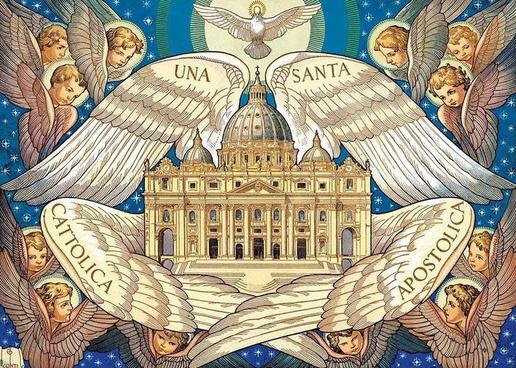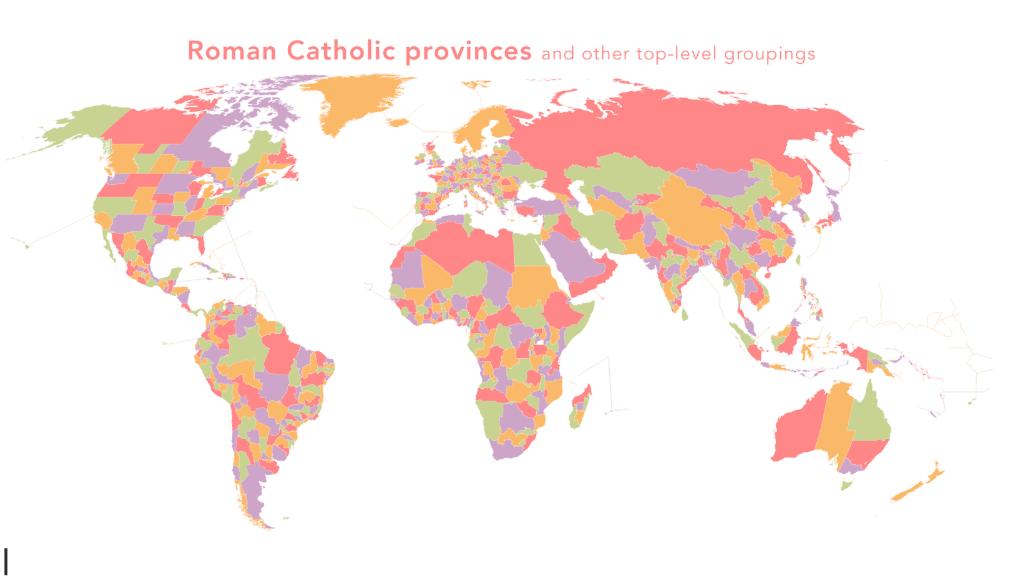
8 minute read
The Return of Catholic Culture: BY ROY WULF '26
The Meaning of “Catholic”
What does the name the Catholic Church actually mean? The word “Catholic” comes from two Greek roots: kata (“concerning”) and holos (“the whole”) Catholic thus means “according to the totality” or “in keeping with the whole ” In Latin, this expression is universum (“combined into one” / “combined in the whole”) As for “Church,” this is a translation of the Greek word ekklesia, meaning “assembly,” which refers to the community of Christian people Therefore, “the Catholic Church” might be said to reference “the Universal Community” or “the One Community” of Christians
The universality of the Church comes from the founding Christianity. In John 17:20-23, Jesus prays, “I pray not only for them, but also for those who will believe in me through their word, so that they may all be one, as you, Father, are in me and I in you, that they also may be in us, that the world may believe that you sent me. And I have given them the glory you gave me, so that they may be one, as we are one, I in them and you in me, that they may be brought to perfection as one, that the world may know that you sent me, and that you loved them even as you loved me ” As we see, Jesus asks for complete unity among His followers In spite of this, we sadly observe a great many divisions in Christianity today.
In Acts 5:11 and 15:22, St. Luke uses the phrase holen ten ekklesian (“the whole church ”) The earliest Christians were united as one Church founded by Christ and led by St Peter, who made decisions with the other apostles from Jerusalem. The first recorded instance of using the word Catholic to describe the Church was by St Ignatius, the third Bishop of Antioch, who was ordained by St Peter himself In AD 107, Ignatius wrote, ”Wherever the bishop appears, let the people be there; just as wherever Jesus Christ is, there is the Catholic Church” (St Ignatius, Letter to the Smyrneans 8:2). Interestingly, it was also in Antioch that the word Christian was first used to describe followers of Christ, as mentioned in Acts 11:26.
Descriptions of worship from these early times reinforce the idea that the Catholic Church today is the continuation of the Catholic Church that St. Ignatius wrote about. For example, in AD 165, St. Justin Martyr described worship He wrote that on Sunday, Christians gather together and “the memoirs of the apostles or the writings of the prophets are read ” The celebrant then “verbally instructs and exhorts to the imitation of these good things ” and then “ all rise together and pray ” After this, “bread and wine and water are brought” and the celebrant “offers prayers and thanksgiving” Justin Martyr explains that “this food is called among us Eucharistia of which no one is allowed to partake but the man who believes that the things which we teach are true, and who has been washed with the washing that is for the remission of sins, and unto regeneration, and who is so living as Christ has enjoined For not as common bread and common drink do we receive these; but in like manner as Jesus Christ our Savior, having been made flesh by the Word of God, had both flesh and blood for our salvation, so likewise have we been taught that the food which is blessed by the prayer of His word, and from which our blood and flesh by transmutation are nourished, is the flesh and blood of that Jesus who was made flesh” (Justin Martyr, First Apology, 66-67).

The Nicene Creed, developed between AD 325 and AD 381, describes the Church as “One, Holy, Catholic, and Apostolic.” For a church to describe itself as “catholic” (or universal) is obviously different from associating itself with a particular nation state or geographical region in the way, for example, the Church of England relates itself to England or the Russian Orthodox Church to Russia It is also different from having an association with a particular person, such as how the Lutheran Church associates itself with Martin Luther For this reason, the word “Catholic” in the Nicene Creed might require further explanation for non-Catholic Christians.
I myself am a convert to Catholicism from the Episcopal Church. The word “Episcopal” means led by bishops In this way, this denomination describes itself as apostolic. The Episcopal Church is in the Anglican Communion (along with the Church of England), so when Episcopalians proclaim the Nicene Creed, reproduced in the Book of Common Prayer, the word catholic is not capitalized, indicating that this is not referring to the institutional Catholic Church Rather, the Episcopalian Book of Common Prayer Catechism states, “The Church is catholic because it proclaims the whole Faith to all people, to the end of time ” The claim is that Christianity is in some invisible way one universal church despite visible institutional divisions that exist This view, of course, is not the position of the Catholic Church On the other hand, Martin Luther simply removed the word catholic from the Nicene Creed, so that the Lutheran Church describes itself as “One, Holy, Christian, and Apostolic.”
The unity of the Catholic Church is greatly aided by having a hierarchy of validly ordained bishops, priests, and deacons who have inherited their clerical offices and their knowledge of the Catholic Faith from an unbroken line of clergy going back to the apostles themselves (i e , apostolic succession), such as how St Ignatius was ordained by St Peter “In like manner,” wrote Ignatius, ”let all reverence the deacons as an appointment of Jesus Christ and the Bishop as Jesus Christ, who is the son of the Father, and the presbyters [ i e , priests ] as the Sanhedrin of God, and assembly of the Apostles Apart from these, there is no Church” (Epistle of St Ignatius to the Trallians, Chapter 3) Catholic bishops, priests, and deacons do not appoint themselves as clergy but inherit their authority from the previous generations of clergy going back to the apostles who were given their authority by Jesus Christ when he founded His Church Because of all of these considerations, today’s Catholic Church identifies Herself as One, Holy, Catholic, and Apostolic, as described in the Nicene Creed.
The title “the Roman Catholic Church” has also become commonplace This was developed by Anglicans to associate the Catholic Church with a particular geographical location: The Holy See in Rome Admittedly, this is not inaccurate, as the Holy See is located in Rome, but the Church has never in Her official documents referred to the whole Church as the Roman Catholic Church In addition, the term can be misleading as there are Churches (i e , communities) within the entire Church besides the Roman Church For example, there is also the Greek Catholic Church (that uses Greek, among other languages), and there is the Syriac Catholic Church (which uses Aramaic, the language Jesus spoke). About 10% of the population of Ukraine belongs to the Ukrainian Greek Catholic Church (part of the Byzantine Rite of Greek Catholicism) The Catholic Church indeed supports many Churches and Rites that are nonetheless all the Catholic Church by being in communion with the Pope, the Bishop of Rome As we know, whenever necessary, the Church elects a new successor to St Peter, the first Pope, and the institution of the Papacy has thus been helpful to unify the Church for the past two millennia.
The Catholic Church states She is Catholic because Christ is present as the head and the unifying force As our catechism reminds us, from Christ, the Church receives the fullness of the faith, the sacraments, and the ordained ministry in Apostolic succession Thus, “the Church was, in this fundamental sense, catholic on the day of Pentecost and will always be so until the day of the Parousia [second coming]” (CCC # 830).
It is also interesting to consider that in recent years, the Catholic Church has truly become universal in the sense of being entirely global in its reach. Almost every country has a diocese headed by a bishop As of June 2024, the Catholic Church comprises 3,172 ecclesiastical jurisdictions, including over 652 archdioceses and 2,249 dioceses, as well as other administrative units across the globe Even those places which do not have a diocese still fall under the authority of a bishop. For example, Saudi Arabia has no Catholic churches, but it is governed under the authority of the Apostolic Vicariate of Northern Arabia based in Bahrain It is estimated that 5% to 7% of the population in Saudi Arabia belong to the Catholic Church More than half of these may be the large number of Filipino guest workers in the country.
Catholics should, as all Christians should, work toward greater unity because Jesus explicitly called for this The challenge to unification is that it seems to require one group or another of Christians to admit to being wrong on a point of doctrine and, in fact, to having been wrong for perhaps centuries However, even if institutional unification eludes us, that does not mean that different branches of Christianity should view one another as opponents Some differences in belief might be due to misunderstanding. Also, even where there are genuine differences in belief, this should not prevent Christians of all denominations from supporting one another and cooperating in many ways.











